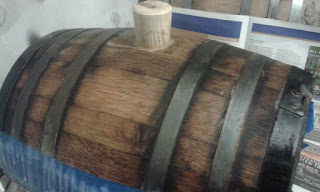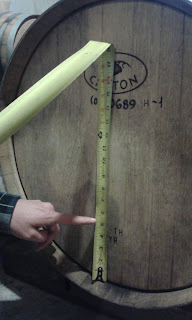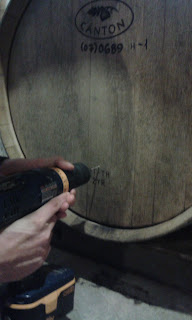Now, the 5 gallon barrels I have were previously wine barrels (a plus) that had been sitting on display for 2 years (a minus). Needless to say, they were not in the best of shape when I got them. The barrels did swell tight, and after I steamed this barrel, I think it should be good to use. However, given its past, I started wondering if the staves on the top of the barrel (where no beer is directly in contact with) might not be drying out and the joints separating just enough to let out some of the C02 produced during this fermentation. (Note: there isn't really an issue with gases escaping now, however, if gas is allowed to enter through these same cracks later, we run the risk of acetobacter ruining the lambic) So I decided to test this hypothesis:
Here I have a piece of wet cloth covering the top of the barrel. In a few minutes the barrel started burping! With my hypothesis proven, I kept the cloth on the top of the barrel, and kept it wet, for about 24 hours swelling these staves from the outside.
I know paraffin wax is commonly used on barrels. When people don't want oxidation or the oak flavor to be imparted on the contents of a barrel, it is poured into the inside and allowed to coat the interior. Obviously I don't want to seal the whole barrel as lambic greatly benefits from that slow oxidation oak provides. I do, however, want to seal part of the barrel. Now that I've re-hydrated the top staves so they are air tight again, I want to lock that in by paraffin waxing just these top staves.
First I tape off a line at about 1/3 of the way down. This is far enough down that the level of the beer inside should always be safely above.
The next step is to coat the barrel with paraffin. I melted a couple blocks in a metal tray and then simply scooped it on with a spoon. This allowed me the control to make sure every bit of the target surface was covered with wax. I could stop here, but its a bit ugly looking with a lot of unnecessary wax.
To remove the excess, I took a blow torch and melted the wax from the top of the barrel down.
WARNING: If you are using a spirit barrel for the first time, do not do this until you have filled the barrel!
WARNING: If you are using a spirit barrel for the first time, do not do this until you have filled the barrel!
As you can see, this leaves a clean looking finished barrel. Only a thin film coats the barrel, and that is all that is needed.
Finally I remove the tape and paper protected the rest of the barrel and you can see the final product! The burping of the airlock has really picked up, even more than after just swelling.
One complaint people have about using 5 gallon oak barrels is the higher surface area beer has to oak, and so the higher level of oxidation that occurs. It makes me think that this might be a good thing to do even if your staves are air tight. I'm not sure how to calculate it, but I'm sure one could figure out what percent of the outside of a 5 gallon barrel should be waxed so that it results in the same relative oxidation as a 60 gallon barrel. I wouldn't be surprised if its the whole outside except for the heads!
Update (02/23): I added the dates (that provided the sugars for a new fermentation) 5 days ago. Since waxing the top, the airlock has been burping about every 7 seconds. Compare this to not burping, and then only burping about every minute after swelling the top. While swelling the barrel from the outside certainly helped, there was still a considerable amount of gas allowed to escape through the stave joints. I feel as though by doing this I have avoided serious problems down the line and hopefully saved the integrity of the lambic in this barrel. Conclusion; I HIGHLY recommend doing this to your barrel if it had sat empty for any substantial amount of time.
Further Update

















